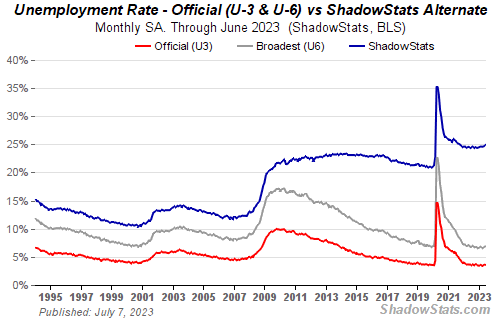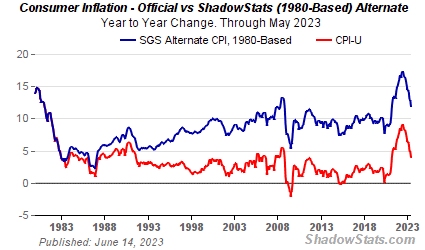Government balance sheets
Federal government tax receipts continue to decline year over year [1], [2], and state and local tax receipts don't look any better [3], [4], [5], [6]. While state and local governments slash their budgets and their staffs, federal government spending remains at or near record high levels as money from stimulus programs is deployed. These two factors have put the federal government on pace for record deficits for fiscal year 2010 [7], [8], [9], [10].
As stimulus funds run out, budgeted spending in several other areas will cause deficits to remain in excess of $1 trillion. The FICA tax is no longer collecting enough to fund Social Security [11]. Military spending continues to expand out of control [12], [13]. Fannie Mae and Freddie Mac which I discussed in a previous post, will need a continual bailout as the housing bubble deflates [14], [15], [16]. Social Security, Medicare, and Medicare will continue to consume a larger and larger percent of the Federal Budget [17], [18]. The FDIC is deeply in the red [19]. A large portion of municipal bond market will either default or require a bailout [20]. Public pension plans are severely underfunded and will require extreme tax increases, partial default, or a federal bailout [21], [22]. Oh, and if that isn't enough, the government is simply lost $98.7 billion last year [23].
The current budget deficits are adding to the an already bleak financial outlook for the federal balance sheet. Federal deficit at the end of fiscal year 2009 was $11.45 trillion. Using generally accepted accounting practices (GAAP) which includes liabilities associated with Social Security, Medicare, and Medicaid, the deficit is $63.6 trillion [24]. These numbers don’t include the cost of continuing to bailout Fannie Mae and Freddie Mac, new healthcare mandates, future bailouts of state governments, and bailout of public pensions. When you add up all debts (public and private) they equal 850% of GDP [25]. Folks, this will not end well..
Sovereign Debt Crisis
With politicians in Washington unwilling or unable to do the math [26], the future solvency of the US government lies in doubt. There is already indication that we are buying our own debt to fund our spending and to maintain low interest rates [27], [28], [29]. This action is simply a poorly disguised way to print money. While this policy may be tolerated over the short term, several bond experts expect interest rates to rise over the next two years [30], [31], [32]. Increasing interest rates will cause debt service to consume a larger and larger proportion of the Federal budget and U.S. GDP [33].
While attempts will be made to fill the deficit by increasing taxes [34], [35], this “solution” will only delay what I view as the inevitable conclusion. In order to clear government debts at all levels, default is the only option. While state and local governments may explicitly default on their bonds and slash their pension obligations by revoking promised benefits. The federal government is likely to take the least responsible and most painful path, outright money printing. From Bloomberg:
Nobel laureate Joseph E. Stiglitz said the prospect of a default by the U.S. or the U.K. is an “absurd” notion constructed in financial markets. Both nations “deserve to keep the Aaa rating” and “the likelihood of a default is so small, particularly in the U.S. because all we do is print money to pay it back,” he said in response to questions after a speech in London yesterday. “The notion of a default is so absurd, it’s another reflection of the absurdities in the financial markets.” [36]
Outright money printing will lead to a crisis in the bond market. Sometimes a sovereign debt crisis quickly precipitates into a currency crisis. Historically in this scenario, some citizens are able to escape the crisis by moving their assets into another country’s currency, but as the above figure shows, most of the governments in the developed world are insolvent [37], [38]. If a currency crisis is triggered in one major economy, it is likely to stretch across the globe. Let me emphasize that this outcome is not yet a certainty, but my personal view is that politicians are unwilling to force the necessary sacrifices on the American people. Therefore, unless behavior changes dramatically in short order, deficit spending will not sustained for the next decade because we will enter a sovereign debt crisis, and perhaps a currency crisis/hyperinflation.
Lessons from current events
You have certainly heard the news of the ongoing sovereign debt crisis in Greece. While Greece may still get bailed out, this route is an option only because their economy is small [39]. Unfortunately, the other so called PIIGS countries are approaching the point where they too may enter a sovereign debt crisis. Over the next three years, these countries will need to issue around $2 Trillion in bonds (debt) [40]. This money does not exist and will need to be printed. On the other hand if governments decided to default, it would destroy major banks in both Europe and the US [41]. The precedent set by TARP is that the politicians will not allow the banks to fail. The banks will return the favor and buy government bonds. Unfortunately, this scenario continues the current trend [42]. It leaves little money to loan to private entities which should result in the further deterioration of small business and the overall economy.
Update: As I was completing this post, a nearly $1 Trillion (~750 Billion Euro) bailout package was put together by central banks are around the world to "stabilize" Europe and its banks. As I stated, this money was created out of thin air. The U.S. Federal Reserve was responsible for ~$50 Billion of this package.
Hyperinflation: A Crisis of Confidence
While the exact timing of a US sovereign debt crisis is uncertain, you can predict this outcome by doing a little math. Simply look at the growth in debts versus the growth in GDP. Very soon, total debt will run grow too big be serviced by GDP (total incomes). Eventually, the citizens will awaken to the fact the government is willing to print money to pay them back. If citizens' confidence in US dollars fails, they panic and the rush into tangible assets begins. Anything not invested in secure tangible assets or companies not relying on non-discretionary spending will undergo a dramatic fall in value. Paper assets like annuities and government debt will be nearly wiped out because they will be priced in devalued US dollars. Protect your family, protect your wealth, and protect your future, buy some tangible assets like gold and silver immediately. Gold and silver are insurance against a total failure of the financial system. You can read another excellent analysis of this topic here [43].
Timing of the crisis
Let me clear, the United States may not be the first major economy to fall. Beyond the PIIGS countries, Japan is at risk of a sovereign debt crisis [44]. The U.K is also at risk [45]. These countries may try to implement all sorts of policies to avoid this outcome [46] including nationalization of citizens' assets (see Argentina 2008). These policies will fail as those of the past two decades [47]. No amount of 'policy' can change the mathematics. So while the timing of the failure is unknown, the U.S. government is now bankrupt [48]. We need to start making adjustments to our personal affairs and demand the federal government begin adjusting as well. A sudden, forced adjustment due to a crisis in the financial markets would be catastrophic to our economy [49].
The financial crisis of Fall 2008 began quietly in spring 2007 with failure small subprime lenders. Some believe, as do I, that the second wave of the financial crisis has now begun and will intensify through the rest of 2010 [50]. When this crisis will peak, no one knows, but the sovereign debt crisis in Greece and the recent shock to the stock market are clear signs of instability in the financial system. Please prepare yourself and your family for tough economic times ahead.
God Bless,
Matt






